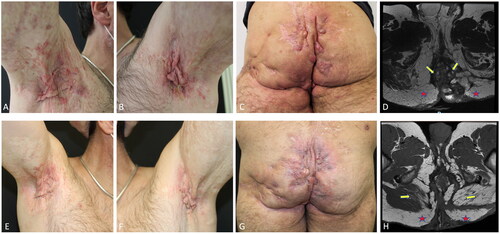Figures & data
Figure 1. HS manifestations of the Axillary and gluteal regions at baseline (A–C) and after 136 weeks of treatment with brodalumab (E–G). MRI of the lower abdomen and pelvis performed at baseline showed widespread morphologic and signal intensity alterations in the subcutaneous soft tissue, localized in the gluteal region bilaterally (yellow arrows). in addition, numerous abscesses mainly involved the gluteus maximus muscle (red stars) but smaller lesions also affected the intergluteal fold and the scrotal region, extending to the pararectal location (D). MRI of the lower abdomen and pelvis performed after 96 weeks demonstrated a reduction in the thickness of the subcutaneous adipose tissue that was associated with fibroadipose involution of the gluteus maximus muscle bilaterally (yellow arrows). fibrotic areas with sporadic abscesses and drainage tunnels are found in the adipose tissue of the ischioanal fossa (red stars). However, a significant reduction of the fluid component was recognized in the locoregional soft tissue compared to the previous examination (H).

Table 1. Patients’ demographics, disease characteristics and brodalumab treatment outcome in all reported patients.
